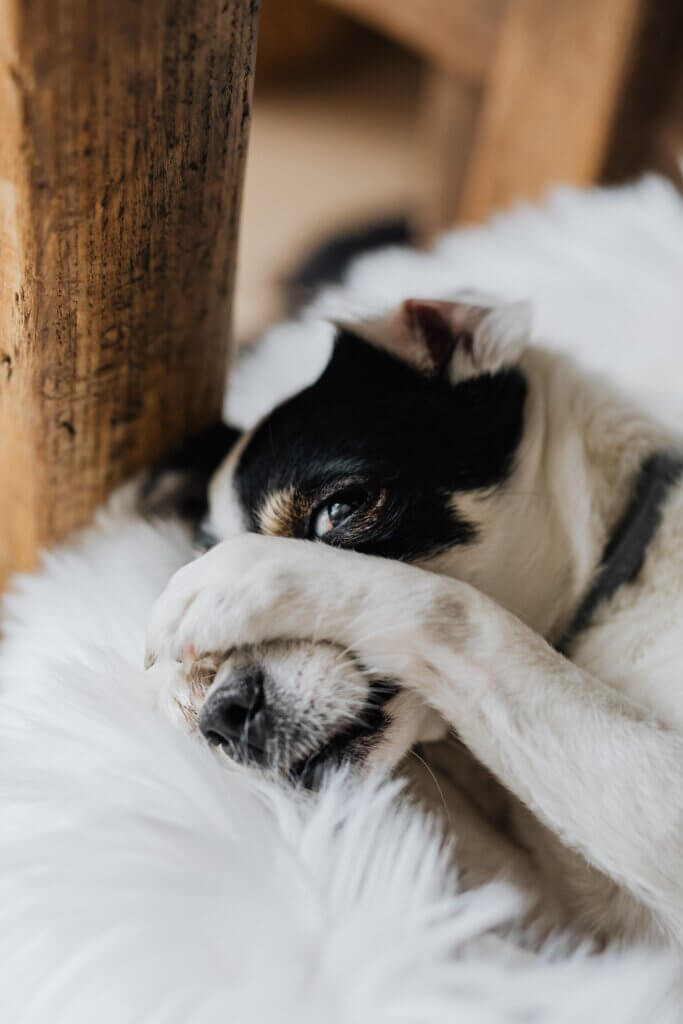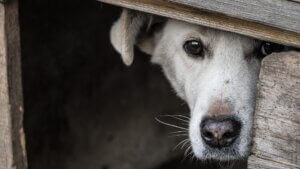6 Ways to Help Scared Dogs Overcome Common Spring and Summer Fears

Is your dog a scaredy-cat? It’s more common than you think. Many people have scared dogs – and it seems more apparent during the spring and summer. Why is this the case? Well, spring and summer provide plenty of time for cleaning and celebrating.
- Vacuums = scared dogs
- Fireworks = scared dogs
- Lawnmowers = scared dogs
Now, factor in thunderstorms that are more common during this time of the year and you’ve got a bunch of scared dogs.
Here’s a personal story about a dog being scared: I was visiting extended family one summer, and the family owned an adult Border Collie. While on the trip, there was a severe thunderstorm. I was awoken during the night by the giant dog escaping his owner’s bedroom and attempting to hide his large body under the trundle bed I was sleeping on. The adults found it hilarious, but the poor dog was scared out of his mind.
Sound familiar?
According to Companion Animal Psychology, “A Finnish study finds that 72.5% of pet dogs show at least one form of canine anxiety.”
Some of the most common dog fears are loud noises, which seem to be amplified during spring and summer.
Fortunately, it is possible to help scared dogs learn how to cope with spring and summer fears.
#1 Recognize the Signs of Scared Dogs
First, you must learn to recognize the signs of scared dogs. Like humans, all dogs respond to fear differently. What you may think is simply disobedience may actually be your dog letting you know he is afraid.
The American Kennel Club (AKC) explains, “Dogs express fear in several ways. They may shake, pace, whine, bark, cower, hide, or even exhibit signs of fear reactivity, which is often confused with aggression.”
Additionally, don’t dismiss common dog behaviors such as tucking in their tails or pulling their ears back. These may be the first signs that your pup is scared.
#2 Teach Basic Obedience
Many people mistake fear for disobedience, such as when a dog starts jumping in and out of a chair during a thunderstorm. By teaching your dog basic obedience skills, such as “Come,” “Sit,” and “Stay,” you will be able to redirect and reward your dog when he is frightened.
#3 Visit Your Vet
If your dog’s fears seem to be affecting his or her quality of life (or yours), it is wise to visit your veterinarian to get their assistance. They can help determine if there may be an underlying cause or if your dog needs treatment, such as behavior modification or drugs, to help overcome these fears.
The Bark suggests, “The first step should be a thorough medical evaluation to determine if health problems are playing a role. Dogs who are in pain may develop fear of anything that exacerbates the pain, such as being touched, being approached by a playful dog, a leash or collar, or a sport class like agility. Older dogs may develop fears and phobias following physical changes, including cognitive deterioration or loss of sight or hearing.”
#4 Advocate for Your Scared Dog
Once you are aware of your scared dog’s triggers, you must advocate for your dog. For example, if you know fireworks are a problem for your dog, keep them inside on the Fourth of July. If you know your dog is scared of strangers, don’t allow strangers to pet her. If your dog can’t handle the robotic vacuum cleaner, run it when he is outside on a walk or sleeping in his kennel in a different room.
#5 Swaddle Your Dog
The ThunderShirt is popular with owners of scared dogs. As the name suggests, it was initially designed to help ease dog’s anxiety during thunderstorms. VCA Hospital explains, “When worn properly, anxiety wraps distribute pressure over the back and sides of the dog’s chest, serving as a calming ‘hug.’ Scientifically, gentle pressure releases chemicals called endorphins that promote a sense of well-being.”
#6 Don’t Encourage the Fear
You must find the balance between comforting your fur-baby and not encouraging fears. For example, if your dog jumps on and off the couch when he is scared, you don’t want to use the same voice you use when you reward good behavior to try to calm him. This may incorrectly teach him this is the right response to this fear of thunder. Instead, you want to remain calm, use basic commands, and then reward your dog with cuddles when he obeys the commands.
While we can’t ease your dog’s fears, we can ease your fears by ensuring our crew members show up in marked vehicles and always lock gates behind them.




